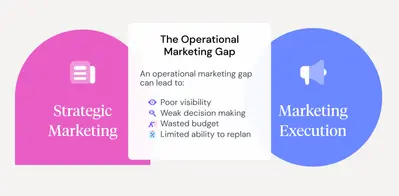Explore Solution Hub - our brand new library of pre-built solutions and interactive tours
Learn More →Marketing Leadership: 4 Tactics to Lead a Successful Team

Chief Marketing Officers (CMOs) have one of the shortest tenures of any C-Suite executive.
According to research from Spencer Stewart, most CMOs spend an average of 4.2 years in the position — a stark contrast to CEOs, who average 6.7 years on the job.
The role of a marketing leader is no walk in the park.
Not only do CMOs serve as strategic advisors across their entire organization, but they also have to work closely with their CEO to balance the needs of the business with the needs of the consumer.
The challenge, then, for most marketing leaders becomes a simple question: How can you manage all of these different expectations and still drive business value?
In this article, you’ll learn about the top skills marketing leaders must develop to lead their teams successfully. Plus, you’ll see how to conquer challenges like imposter syndrome and tips to redefine the perception of marketing leadership in the digital era.
With the abundance of sophisticated software tools at our disposal, you’d think the job would become more manageable. Really, it’s about investing in the proper technology, not tech for tech’s sake.
Marketing leaders are also focused more on proving the value of marketing efforts and building new opportunities for strategic growth. While the team is in the weeds with tactical responsibilities, CMOs oversee these efforts while thinking more holistically about strategy.
This kind of strategic thinking comes with unique challenges, like imposter syndrome and proving the value of your efforts. Let’s break down some of the major challenges faced by CMOs today.
1) Marketing leaders overwhelmingly feel imposter syndrome
CMOs are expected to lead their teams with confidence and authority, and often face a crippling challenge known as imposter syndrome.
Below are a few common causes of imposter syndrome for marketing professionals:
- Proving marketing ROI to top executives is challenging: Marketing leaders are under constant pressure to demonstrate the value of their strategies to the C-suite. This challenge underscores the importance of effective marketing leadership in aligning marketing efforts with overall business objectives.
- Limited visibility into team activities creates uncertainty: The unique landscape of modern marketing teams, often composed of specialists, can make it difficult for leaders to view all ongoing activities.
- Pressure to create demand immediately without fully understanding the business: Marketing leaders must often generate immediate results, which necessitates a deep understanding of both the market and the organization’s objectives.
- Excessive time spent on tactical issues hinders strategic focus: Balancing tactical and strategic marketing efforts is essential. Effective marketing leadership involves optimizing planning and processes to ensure efficient allocation of resources.
2) Marketing teams tend to be hyper-specialized
A balance between specialization and diversity in skill sets is crucial for effective marketing execution.
The marketing department is different from other departments. It is made up of a wide range of teams: operations, product, content, events, and demand generation. Within each of those teams are hyper-specialized individuals.
Other departments, like finance, accounting, or sales, tend to have a similar skill set among their team members.
As a marketing leader, you probably started as a specialized team member and now are uniquely positioned to be a generalist to support your entire team.
For marketing leaders, the challenge of managing a multifaceted marketing team is further complicated by the prevalence of specialization within marketing functions. A marketing leadership role involves balancing the strengths of specialization with the need for a diverse skill set within the team.
Today, marketing teams often consist of specialists. This can inadvertently create silos, promote tactical behaviors, and hinder a comprehensive understanding of strategic marketing and company objectives.
This places additional responsibility on marketing leaders to integrate these specialized functions into a cohesive approach. Adding to the complexity is the eclectic nature of marketing, with diverse skill sets required for success.
In some industries, executives from other departments are tasked with leading marketing efforts, even if they are not marketing experts. In such cases, these leaders must relinquish control and let their experienced marketing teams guide the way. Strategic hiring and comprehensive training are the only ways to bridge the significant gap in all these scenarios. Strategic hiring and comprehensive training are the only ways to bridge the significant gap in all these scenarios.
3) Marketing leaders feel pressure to justify marketing spend
Marketing leaders often grapple with the relentless pressure from the highest echelons of their organizations—the CEO, CFO, and board members.
These stakeholders demand concrete evidence of the value derived from the marketing budget. Marketing leaders should aim to track and report the progress of their marketing initiatives with tangible ROI. This includes:
- Tracking the lifecycle of customers from acquisition to retention
- Analyzing the impact of marketing efforts on the bottom line
- Providing relevant benchmarks and peer comparisons
It’s up to you, as a marketing leader, to present data-driven insights. That means being able to tell the story beyond the metrics. Sure, you can talk about impressions and leads, but it’s more helpful to know why those metrics are different from last quarter.
4) Marketing leaders face an operational marketing gap
An operational marketing gap often exists between strategic and tactical marketing efforts.
Many strategic plans are developed, then go unreviewed by executives and leaders of the marketing team, causing a disconnect between the team’s daily execution and business objectives. This leads to stagnant marketing, with activities lacking alignment with long-term goals.
Monitoring and correcting this behavior is a challenge for marketing leaders because of limited visibility into execution and goal performance. This visibility gap results in poor decision-making and budget waste which hampers the ability to quickly replan.
An effective marketing leader needs a way to implement a plan, like a roadmap. Without one, it creates a gap between your strategy and its execution. The result is that your team creates random, ungrounded campaigns or efforts in an attempt to show value and look busy. Sound familiar?
Ultimately, this operational gap fosters confusion, frustration, and a decline in productivity. This causes a death spiral for many marketing teams.
An operational marketing plan can act as a bridge between your team’s strategic marketing and its execution. It lets your teams focus more on tactical ways to reach your goals.

To overcome these challenges, marketing leaders should prioritize creating a powerful marketing strategy that aligns with the overall business goals.
Here are 5 tactics CMOs and marketing leaders can use to lead a successful marketing team:
- Break Down Silos and Foster Collaboration: Encourage cross-functional collaboration within the marketing team and across departments.
- Adapt to Consumer Priorities: Stay agile in responding to changing consumer preferences and market dynamics.
- Cultivate an Agile Marketing Culture: Develop a culture of agility within the marketing function, allowing quick strategy adjustments.
- Optimize Planning and Processes: Streamline and improve marketing planning processes to enhance efficiency.
- Speak the Language of Business: Communicate marketing strategies in alignment with overall business objectives.
As a marketing leader, your main priority is to lead. Embodying these essential characteristics is paramount to success in guiding your team toward achieving their goals.
Instilling these tactics in your marketing team is truly only half the battle. The other half is ensuring your specialized departments can work together to achieve operational marketing excellence.
We know that today’s marketing leaders face many challenges, like imposter syndrome and managing expectations from the CEO. Yet, many existing resources don’t fully explain how to overcome those challenges to become a more successful marketing leader.
That’s why we wrote the book (literally) on how top CMOs can level up their skill sets to build high-functioning teams and help their organizations reach their goals. This eBook guides you to bid farewell to these feelings of inadequacy.
Download our free eBook to learn more.
Latest Posts
Blogs
Interviews, tips, guides, industry best practices, and news.
